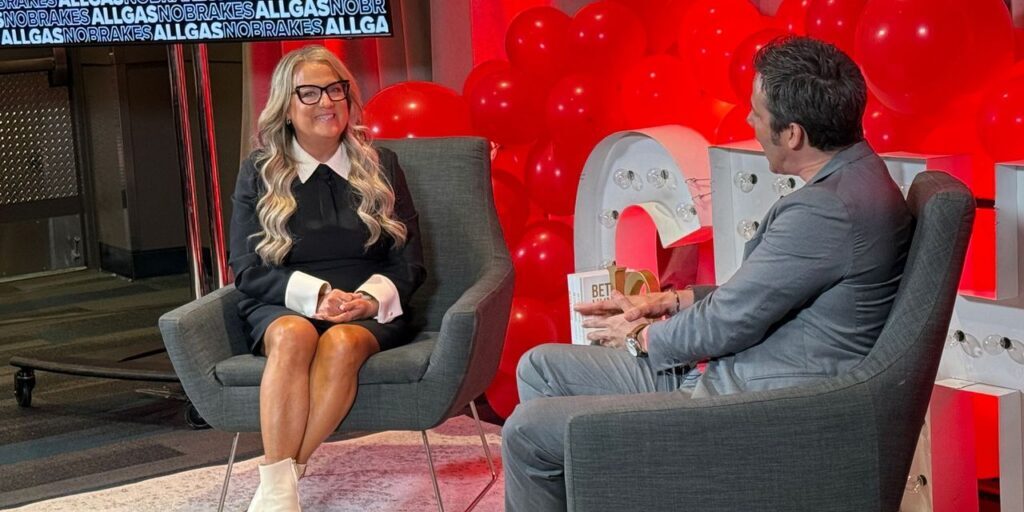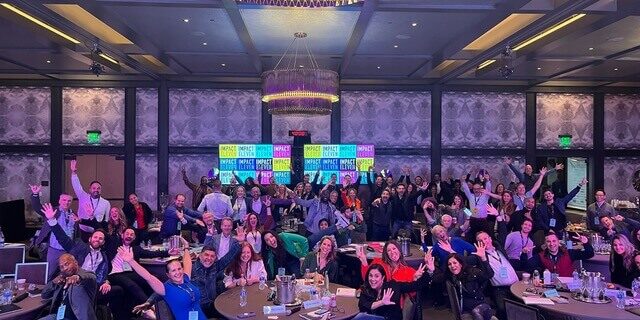Do you have a presentation, speech or wedding toast you want to crush?
Tell a story.
This isn’t just a pro speaker tip. It’s brain science.
Great storytelling inspires us and help us invest in an idea more completely. They create an emotional connection that goes beyond a data set. They compel us to take action. Stories are the most powerful form of persuasive communication, and the best stories can endure the test of time.
Keynote speaker Kindra Hall has mastered the art of storytelling, and I asked her to share her take on what makes a great story.
What are the elements of a good story?
A story is really just a moment. It’s a moment when change happens, a lesson is learned, there’s a thought or interaction. That’s the birth of a story.
Then to build around that, you think about the space behind that moment. What made that moment stand out? What was going on behind the scenes?
And then the last part of a story is the result. What did you learn in that moment, and what can the person listening to the story take away from it?
Can anyone master the art of storytelling?
Telling a great story is all about familiarity. It’s taking a moment in time, or an experience, and making the listener feel familiar with it — so they can picture it in their own minds. Let the audience put themselves in the scene.
The best stories are the ones that your listeners are imagining, using images from their own lives. They’re putting their own experience in the story. The extent to which you can make people do that is the extent to which you’ll be successful.
So, if you think about familiarity as your goal, you can take the most mundane thing and turn it into a story. Sometimes the things that we think are the most mundane can really be the most interesting. Speakers and even executives get stuck thinking they don’t have a story that’s BIG enough to tell, but they don’t realize that it’s more about familiarity than about intrigue or excitement or tragedy or conflict.
I see storytelling as a communal process. It’s so much less about you and your story than it is about the story that’s happening to the person you’re talking to. The more you make the story about them — make it sound familiar so they can see themselves in it — the better it will be.
how can people find their own stories in real life?
I think finding stories is the hardest thing to do because we overlook them all the time. I do a lot of strategic storytelling — telling a story to illustrate a message. The key is to start with the message. Figure out what you’re trying to say, then take one step backward. Ask yourself: When have I seen this message in action?
If your message is about great customer service, think about when you were on the receiving end of excellent customer service. Those moments go by so quickly in our lives, but if you focus and ask yourself questions about a very specific moment, you can find the stories.
It’s also helpful to understand that story is a form of currency. Once you start looking for stories in your everyday life, you’ll start to find them. You can develop a heightened awareness of the stories that are happening all around you.
How did you learn the art of storytelling?
People think about stories as what’s published in books or what’s put on movie screens — we think about big, grand stories. But I got exposure to good storytellers through little festivals.
For years, there was a national storytelling festival in Jonesborough, Tennessee. They would bring in 15,000 people to this tiny town without a single stoplight, just to hear storytellers. And they’d tell these really small stories — things that happened in middle school or stories from when they first started dating — small moments. And they did such a good job of drawing you in. I got to see these master storytellers turning really simple events into hour-long pieces, and that was beautiful to watch.
When did you realize this was what you wanted to do for a living?
I think it started when I was a senior in high school. I saw a guy speaking on stage at the Superdome in New Orleans, and I was like, “Oh my gosh, I want to do that!”
I went through college and grad school, and then I was a VP of sales and did a lot of speaking in that role. And when I started seeing other speakers, I thought the same thing again — “I want to do that!” — but I just didn’t know how.
I got invited to speak at an event. While I was there, I met another speaker so told me, “Oh, yeah. I get paid, like, $10,000 to do this.” And I said, “Excuse me?!” That’s when I decided it was time to figure out how to do this.
What’s been surprising about your life as a professional speaker?
I was just thinking about this the other day. It’s how much happens to make one hour onstage possible.
For example, the other day I was in Minneapolis. I spoke, and then I got in a car and went to the airport. I got on a plane and got off the plane and got in another car and then drove an hour and a half and then went to bed. I got a couple hours of sleep, got up, had to do a soundcheck at 7 a.m. Eastern Time. I was still on Pacific Time. And then I spoke for an hour, I got back in a car, drove another hour and a half, took a flight. It was a total of 14 hours travel and shuttling, just for one hour onstage.
And I think it’s really easy for people to be like, “Oh, you get up for an hour …” and you don’t even think about all the work that goes into the prep in advance. There’s a definite road warrior aspect. And that’s not even including the actual preparation of the material.






![[RYAN] Featured_Why Human-Centered Leadership Is the Future of Growth [RYAN] Featured_Why Human-Centered Leadership Is the Future of Growth](https://ryanestis.com/wp-content/uploads/bb-plugin/cache/RYAN-Featured_Why-Human-Centered-Leadership-Is-the-Future-of-Growth-1024x538-panorama-78e9dc1762c564216c0e9d2780c005b1-.jpg)



